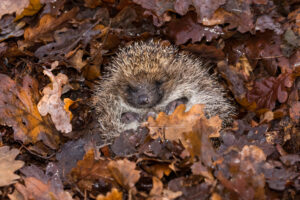
The garden can look like a rather barren place during winter, with not too much going on – or is there? During these colder months the local wildlife will need our help more than ever as food sources disappear and habitats and autumn collected food stores become damaged by bad weather. In this article we highlight how to spot if your garden has visitors and what you can do to help shelter, feed and water these wonderful winter visitors.

- Hibernating Hedgehogs
Witnessing these beautiful prickly creatures in the garden is an increasingly rare and lovely sight to see! Although hedgehogs hibernate in the winter, not all do and not all do for the same length of time. Some need 2 or 3 weeks, others could sleep for England! Providing them with a home to hibernate in is a great way to help. The Natural History Museum has a great tutorial for making your own or various companies sell readymade homes, like this one from Suttons. Choose a sheltered, private spot and scatter some dead leaves around the house which will give a feeling of protection. Once they wake up, food will be on their mind! Try non-fishy tinned dog food or fresh meat. For a source of protein, try some scrambled eggs. Remember to only offer water, not milk as it can be bad for them.
- Frogs, Toads and Newts
Although frogs, toads and newts don’t hibernate, they do begin to slow down during the winter period and when the temperature rises on warmer winter days, they will need to find food.
Creating little places to shelter and rest is a great way to help our pond loving visitors. Piles of logs and leaves give frogs, toads, and newts somewhere to shelter and rest. On the subject of rest, some will choose compost bins as their cosy bed of choice, so be aware of this if you are turning over the compost in the bin. Frogs especially like to rest in the mud in ponds, so breaking the ice on your pond will help the frogs, as well as toads, newts, and fish. Why not have a go at making a hibernaculum for them? The RSPB shows you how.
- Birds
When considering ways to look after garden wildlife in winter, our feathered friends will always hold a top spot on the list. Birds need extra fuel to top up their reserves in winter, as they rely on their body fat to keep warm during freezing cold days. A clean and well-stocked feeder with seeds, fat balls and dried mealworms will help them enormously. Remember to leave food out every day as they will need to build and maintain their stores. Why not make your own fat balls? The Natural History Museum has some great tutorials. You can freeze and defrost as needed! Scattering seeds over frozen shrubs and perennial stumps will allow birds to find and feed at leisure.
- Water
Remember that water will be needed by wildlife too – the trouble with winter is, it’s mostly frozen! Breaking the ice on birdbaths or ponds will help give birds a place to drink from. Remember to do this carefully. Shallow dishes of fresh drinking water can be placed on the ground for animals, but this may make them feel vulnerable. Placing the dish undercover under a bush will make them feel safer and less vulnerable.
Whether you have a large sprawling garden or a balcony with a few window boxes, there are lots of different ways you can help your local wildlife during winter. The Wildlife Trusts website wildlifewatch.org.uk has a wealth of advice, information, Spottersheets and how to guides to help get you started!



